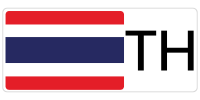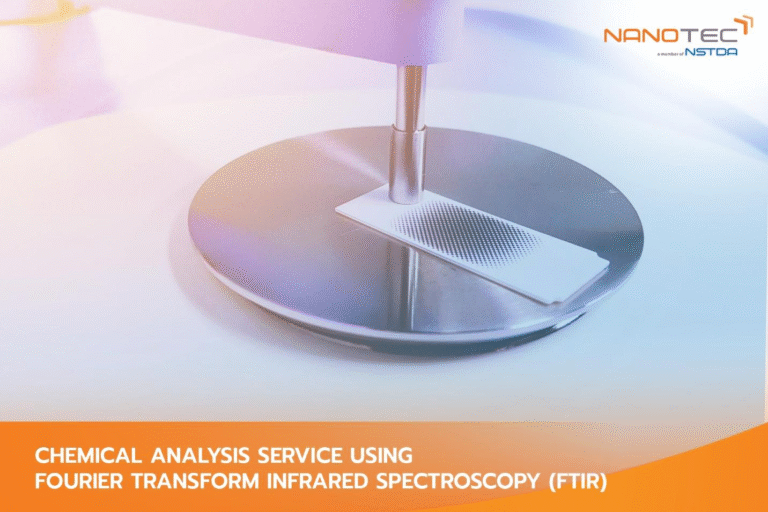Meta description (140–160): Get clear, auditable chemical data with NANOTEC: FTIR, Confocal Raman, Fluorescence, UV-Vis-NIR, GC-MS/GC-MS/MS, HPLC/LC-MS/MS, and ICP-MS—serving textiles, plastics, food, pharma, cosmetics, and electronics under ISO 9001 and ISO/IEC 17025.
SEO Keywords: chemical analysis thailand, ftir spectroscopy, confocal raman spectroscopy, fluorescence spectroscopy, uv vis nir spectrophotometer, gc ms headspace thailand, gc ms ms pesticide analysis, hplc lc ms ms contaminants, icp ms elemental analysis, materials and food testing thailand
Why Chemical Analysis Matters
When you’re developing or qualifying a product, the composition and chemical behavior of your materials determine safety, performance, shelf life, and regulatory acceptance. Small differences—trace contaminants, solvent residues, mislabeled raw materials—can derail production or trigger returns. What teams need is definitive, method-backed chemical data that stands up to QA review and external audits. NANOTEC’s Chemical Analysis Services provide exactly that: a coherent suite of spectroscopy and chromatography-mass spectrometry methods that translate raw samples into decision-ready results. We support industry clients across textiles, plastics, food, pharmaceuticals, cosmetics, and electrical/electronic sectors, connecting routine QC questions to deeper R&D when required.
What This Service Covers
NANOTEC offers analytical testing and technical services in nanotechnology, bridging private-sector users from routine analytical testing to research support. Within chemical analysis, our core toolsets include:
- Fourier Transform Infrared Spectroscopy (FTIR)
- FTIR identifies functional groups by measuring infrared absorption and reporting characteristic wavenumbers. Use it to confirm incoming raw materials, screen for degradation/oxidation, or compare a suspect lot to reference spectra.
- Confocal Raman Spectroscopy
- Raman spectroscopy measures molecular vibrations via laser excitation, offering a complementary fingerprint to FTIR. Confocal Raman enhances depth resolution to probe subsurface layers—ideal for core-shell structures or multi-layer coatings where you need layer-by-layer chemical information and chemical distribution across a mapped area.
- Fluorescence Spectroscopy
- By exciting a sample and detecting emitted light, fluorescence reveals chromophores and trace aromatics with high sensitivity. Our typical wavelength window is 200–900 nm, useful for investigating antioxidants, optical brighteners, and formulation changes that affect product appearance or stability.
- UV-Vis-NIR Spectroscopy
- Quantify absorbance, % transmittance, and % reflectance from 200–2,000 nm. This broad range supports color/appearance control, film/filter characterization, and quick concentration checks when an analyte has a known extinction profile.
- GC-MS (with Headspace) and GC-MS/MS
- Analyze volatile organic compounds (VOCs) and semi-volatiles—components in essential oils, active compounds in medicinal plants, pesticides, phthalates, naphthalene, residual solvents in foods, packaging, and the environment, plus hydrocarbons from petrochemical streams. Headspace sampling is available for volatiles; MS/MS adds selectivity/confirmation for complex matrices.
- HPLC and LC-MS/MS
- Separate and quantify non-volatile or thermally labile analytes. Typical applications include pesticide/herbicide residues, contaminants in food and environmental samples, and drug/medical/pharmaceutical targets. LC-MS/MS provides sensitivity and specificity in challenging matrices where HPLC-UV alone may be insufficient.
- ICP-MS (Elemental Analysis)
- Measure elements and their concentrations using atomic spectroscopy. ICP-MS supports trace-level metals quantification across raw materials, finished goods, and environmental samples where elemental compliance or contamination risk is a concern.
Where This Fits in Product Development
Chemical analysis underpins three moments in your product lifecycle:
- Incoming material control. Verify identity and purity of raw materials; screen for restricted substances and residuals that affect safety, smell, or performance.
- Formulation and scale-up. Track degradation pathways, solvent removal, or off-flavor precursors; confirm label claims with quantitative methods.
- Release and compliance. Produce auditable reports for customers, regulators, and retailers—evidence that ingredients and finished goods meet your specification.
Because all methods are housed within the same program, results are easier to compare and compile into a coherent dossier.
Accredited Quality Framework
NANOTEC operates within an ISO 9001 quality management system and offers ISO/IEC 17025 accreditation for specified scopes. This provides confidence that our results are produced using validated methods, calibrated instruments, and documented procedures appropriate for review by QA teams and external partners.
Typical Deliverables
- Spectra & Chromatograms: FTIR/Raman/Fluorescence spectra; UV-Vis-NIR curves; GC-MS or LC-MS/MS chromatograms with identification and quantitation where applicable.
- Quant tables: target analyte list, retention times, qualifier/quantifier ions (MS), calibration range, LOD/LOQ where part of the method, concentration results, and units.
- Method summary: preparation approach, instrument model, key parameters (columns, mobile phase/gradient for LC, ion source/transition lists for MS/MS; lamps/monochromator for UV-Vis; laser line/objective for Raman).
- Interpretive notes: pass/fail against your internal limits where provided; flags on unusual peaks or potential interferences.
Sample Guidance (What to Prepare)
- Clearly labeled samples (lot numbers, intended test list); note hazards or handling requirements.
- Reference standards or specification limits if you want pass/fail interpretation.
- Matrix information (e.g., oil, aqueous, polymer, herbal extract) to choose suitable prep and avoid artifacts.
- For trace analyses, supply clean containers and avoid cross-contamination; store light-/air-sensitive samples appropriately.
- For layered samples (coatings/films), include cross-sections or request Confocal Raman for depth profiling.
Who This Service Is For
- Corporate & OEM/ODM.
You need audit-ready chemical data to control suppliers, validate changes, and pass retailer/reviewer scrutiny. We deliver method-based results you can drop into QA and customer documentation. - SMEs.
You want the right test list, not the longest—clear identity checks, residue screens, and targeted quant that inform action. We’ll explain results in plain English and help you avoid unnecessary spend. - Universities & Research Institutes.
You need standardized, publishable outputs with spectra/chromatograms that support hypotheses and tech-transfer. Confocal Raman, LC-MS/MS, and ICP-MS provide depth for advanced studies. - Tech Startups.
You need signal fast—does the sample contain what it should, and are impurities/residuals within expectation? Start lean with FTIR/UV-Vis/GC-MS screens; expand to LC-MS/MS or ICP-MS as you refine. - Overseas Customers/Investors.
You need English-led reports and recognized quality systems (ISO 9001, ISO/IEC 17025) for cross-border review, due diligence, and partner alignment.
Pricing Overview
Use the guide price below to scope your program; formal quotations depend on analyte list, matrix complexity, and confirmation requirements (e.g., MS/MS).
- Chemical analysis services: from THB 600 per item
- Available methods: FTIR, Confocal Raman, Fluorescence (200–900 nm), UV-Vis-NIR (200–2,000 nm), GC-MS (with Headspace) / GC-MS/MS, HPLC / LC-MS/MS, ICP-MS (elements)
- Add-ons: method development/transfer, multi-analyte panels, confirmation with MS/MS, expanded calibration range, and report customization
Frequently Asked Questions (recap only)
Which chemical techniques are available?
FTIR, Confocal Raman, Fluorescence (200–900 nm), UV-Vis-NIR (200–2,000 nm), GC-MS/GC-MS/MS (with Headspace), HPLC/LC-MS/MS, and ICP-MS (elements).
What industries do you support?
Textiles, plastics, food, pharmaceuticals, cosmetics, and electrical/electronics, among others.
Do you operate under recognized quality systems?
Yes—ISO 9001 quality management, with ISO/IEC 17025 accreditation for specified scopes.
What will the report include?
Spectra/chromatograms, quant tables (where relevant), method summaries, and notes mapped to your limits or questions.
How do I decide which method to choose?
Share your target analytes, matrix, and decision use (ID vs quant vs screen). We’ll propose a fit-for-purpose method set—starting lean, adding confirmation only where needed.
Suggested Internal Links (provisional; finalize later)
- Testing & Analysis Hub
- Surface Analysis (AFM, NMT, Contact Angle, BET)
- DLS — Particle Size & Zeta Potential
- Microbiology / Antibacterial Testing
- Pilot Plant — Nanoparticles & Cosmetics Production
Call to Action
Request a chemical analysis plan or book a consultation to select the most efficient method set for your sample and decision need. We’ll deliver clear, auditable data that drives action.Infrastructure Services
National Nanotechnology Center (NANOTEC)
143 INC 2 (B), Thailand Science Park, Phahonyothin Road, Khlong Nueng, Khlong Luang, Pathum Thani 12120
Tel. +66 2 564 7100 ext. 6517, 6625, 6680
Email: bdis-infs@nanotec.or.th


